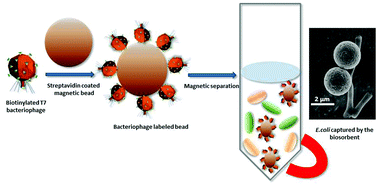Development of a novel bacteriophage based biomagnetic separation method as an aid for sensitive detection of viable Escherichia coli
Abstract
The application of bacteriophage combined with the use of magnetic separation techniques has emerged as a valuable tool for the sensitive identification and detection of bacteria. In this study, bacteriophage T7 labelled magnetic beads were developed for the detection of viable bacterial cells. Fusion of the biotin acceptor peptide (BAP) with the phage capsid protein gene and the insertion of the biotin ligase (BirA) gene enabled the display of the BAP ligand and the expression protein BirA during the replication cycle of phage infection. The replicated Escherichia coli specific bacteriophage was biotinylated in vivo and coated on magnetic beads via streptavidin–biotin interaction. Immobilization efficiency of the recombinant phage was investigated on magnetic beads and the phage-bead complex was evaluated by detecting E. coli from inoculated broth. When compared to the wild type phage, the recombinant phage T7birA–bap had a high immobilization density on streptavidin-coated magnetic beads and could capture 86.2% of E. coli cells from broth within 20 min. As this phage-based biomagnetic detection approach provided a low detection limit of 102 CFU mL−1 without pre-enrichment, we believe this assay could be further developed to detect other bacteria of interest by applying host-specific phages. This would be of particular use in detecting bacteria which are difficult to grow or replicate slowly in culture.


 Please wait while we load your content...
Please wait while we load your content...